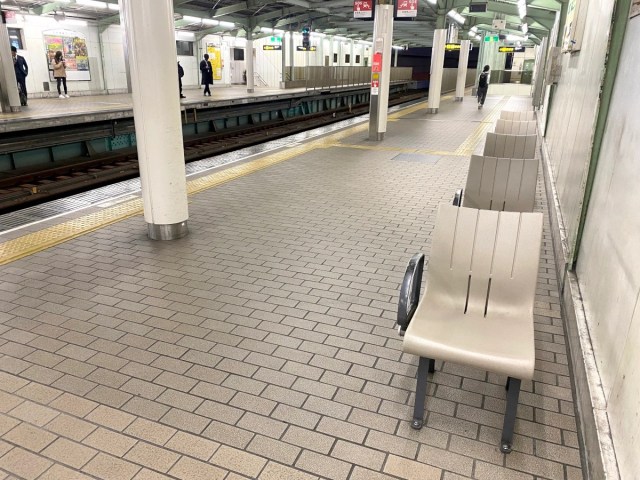
Unusual design in Kansai is a clever example of thoughtful customer service, designed specifically with the user in mind.
Osaka, in the Kansai region, and Tokyo, in the Kanto region, pride themselves on doing things differently from each other, whether it involves rice balls at a convenience store or the way miso soup is positioned at the table.
The differences don’t stop at food, however, because at train stations in the Kansai area, you’ll find that seats on some platforms look very different from those in Tokyo.
▼ An example of seats at a Tokyo train station…
▼ …and an example of seats at a train station in Osaka.
Our Tokyo-based reporter P.K. Sanjun took a trip to Osaka recently, and when he saw the seats he couldn’t help but wonder about the real reasons behind their design. Was this simply another case of Osaka doing things differently to Tokyo? Or was there another factor at play here?
In order to find out, he went straight to the local railway operator, West Japan Railway Company, to ask them why the seats are positioned away from the trains and their tracks, and they revealed three fascinating reasons for the design.
P.K.: I’ve seen this at stations in Osaka and Hyogo so I wanted to ask — why are the seats facing parallel to the platform? It’s something you don’t see in Kanto…”
JR West: “Well, the main reason is to prevent drunken customers from falling (onto the tracks). Until they were installed, there were numerous cases where drunk customers who’d been sitting on the seats stood up and fell off the platform.”
P.K.: “So it’s to prevent drunken people from falling off the platform? Does that mean the design was different before?”
JR West: “Yes, it would take some time for me to check when they were formally introduced, but from what I remember the new seat configurations first appeared around five to six years ago.”
P.K.: “Hmmm. But if the purpose is to prevent falls, shouldn’t platform doors be installed instead? I feel like I’m seeing a lot more of them at stations in the city centre.”
JR West: “I understand what you’re saying. However, Kansai has a complicated network of routes, so it may be a little difficult to install platform doors everywhere. Major stations such as Osaka, Tsuruhashi, Kyobashi, and Sannomiya have platform doors, though.”
▼ Compared to Osaka, Tokyo currently has a lot more of these platform doors installed at stations.
P.K.: “I see. I guess the installation of platform doors must be very costly. Seats might be a more cost-effective countermeasure.”
JR West: “I don’t know the details of the cost, but I think that’s probably part of the reason. JR West has been changing the seat positions at a large number of station platforms over the past few years.”
P.K.: “Well, that clears things up! Thank you!”
Following his conversation with JR West, P.K. discovered that the main reason for the unusual seat positioning was to protect drunken customers from falling off the platform. And sure enough, when he was passing through another station in the region, he found a poster showing the change in the position of the seats, along with an explanation that the new configuration was designed to protect against drunken falls.
Drunken falls are a big problem at train stations throughout Japan, so much so that you’ll commonly find posters warning commuters of the dangers. It’s one of the reasons why platform doors are being installed at a number of stations but given the costs involved, and the fact that Japan’s rail network is wide and varied, a nationwide rollout would be a difficult and time-consuming task.
Still, while there are hurdles to making hurdles, that doesn’t mean a railway operator in Japan will sit on its hands and claim nothing can be done to fix the problem. So kudos to JR West for looking for an alternative solution and coming up with the simple yet effective idea to change the position of the seats.
▼ A simple change has the potential to save lives.
The seats at Kansai train station platforms are yet another example of how Japan’s dedication to customer service can lead to innovative UX (user experience) design that creates a meaningful, relevant, and memorable experience for users.
It’s a simple design idea that makes a big difference to the daily life of customers, just like elevators with mirrors, red-and-yellow markings on stairs and even giant locks on Japanese toilet doors!
Photos ©SoraNews24
● Want to hear about SoraNews24’s latest articles as soon as they’re published? Follow us on Facebook and Twitter!
[ Read in Japanese ]

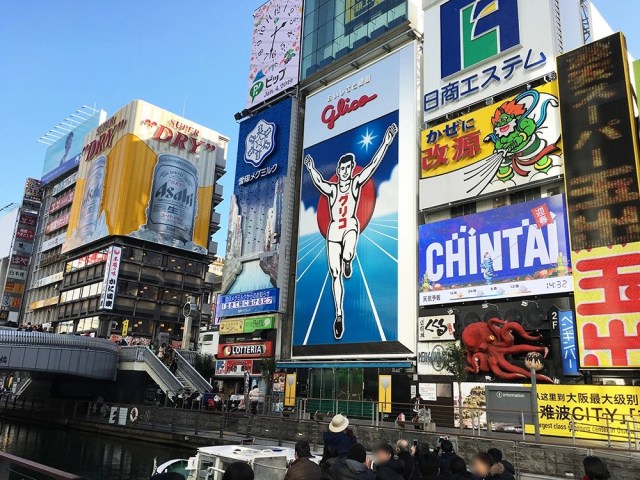
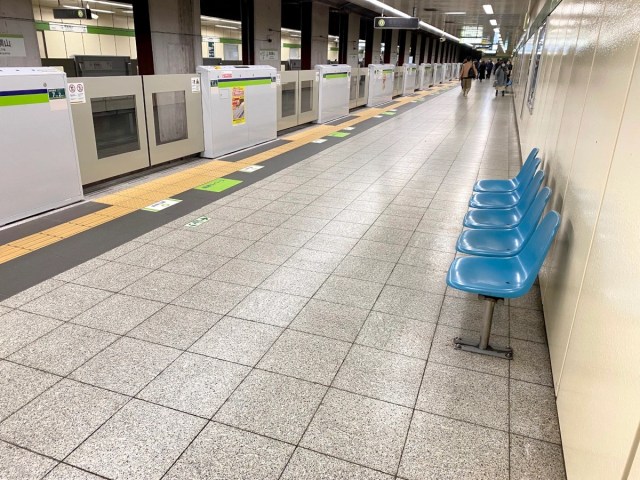
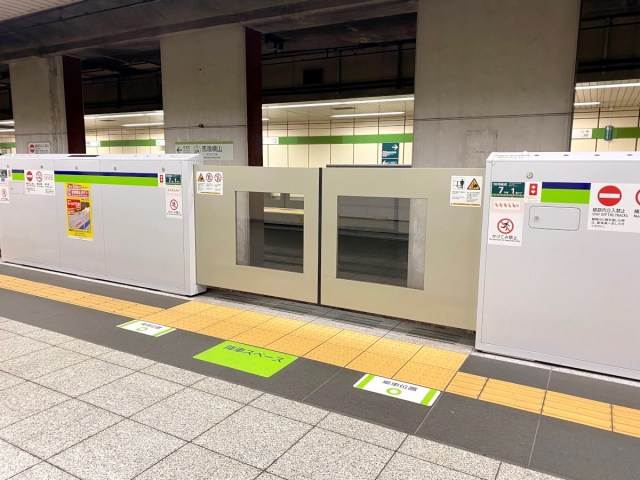

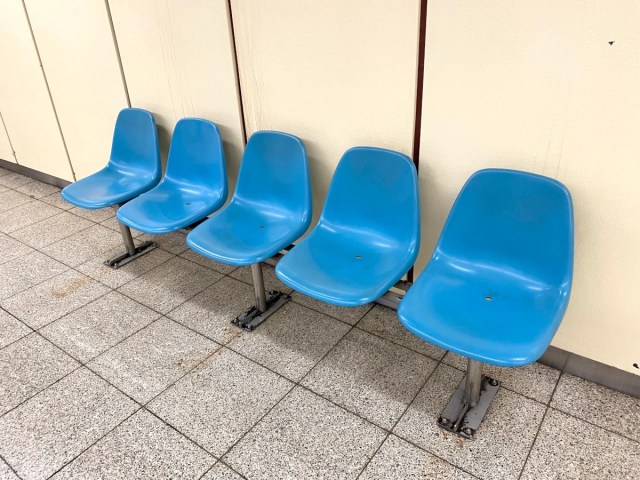
 New Japanese mascot character: A train station monster that grabs children who don’t mind the gap
New Japanese mascot character: A train station monster that grabs children who don’t mind the gap Japan travel alert: Cheapest seats on fastest Shinkansen will not be offered for Golden Week
Japan travel alert: Cheapest seats on fastest Shinkansen will not be offered for Golden Week Japanese train station building set up in just two hours with the help of 3D printing
Japanese train station building set up in just two hours with the help of 3D printing Shinkansen to permanently reduce number of inexpensive non-reserved seats on Nozomi trains
Shinkansen to permanently reduce number of inexpensive non-reserved seats on Nozomi trains Sanyo Shinkansen ending in-car food cart sales (unless you’ve got the cash for first-class)
Sanyo Shinkansen ending in-car food cart sales (unless you’ve got the cash for first-class) Rakuten randomly offers 58 New Year’s osechi feasts in Japan, but did we get a star or a dud?
Rakuten randomly offers 58 New Year’s osechi feasts in Japan, but did we get a star or a dud? Starbucks Japan ready to get Year of the Horse started with adorable drinkware and plushies【Pics】
Starbucks Japan ready to get Year of the Horse started with adorable drinkware and plushies【Pics】 Tokyo accommodation: Capsule hotel offers unique sleep and sauna stay for women
Tokyo accommodation: Capsule hotel offers unique sleep and sauna stay for women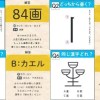 What does a kanji with 12 “kuchi” radicals mean? A look at weird, forgotten Japanese characters
What does a kanji with 12 “kuchi” radicals mean? A look at weird, forgotten Japanese characters Japanese man gets fired for lying on resume by saying he had less education than he really does
Japanese man gets fired for lying on resume by saying he had less education than he really does Original Totoro plush toys from 80s and 90s re-issued for Studio Ghibli exhibition
Original Totoro plush toys from 80s and 90s re-issued for Studio Ghibli exhibition Super Budget Dining in Japan – What’s the best way to spend 1,000 yen (US$6.70) at Saizeriya?
Super Budget Dining in Japan – What’s the best way to spend 1,000 yen (US$6.70) at Saizeriya? Dragon Quest Burgers and Slime drinks are coming to McDonald’s Japan【Video】
Dragon Quest Burgers and Slime drinks are coming to McDonald’s Japan【Video】 More people in Japan quit sending New Year’s cards and many have started to regret it
More people in Japan quit sending New Year’s cards and many have started to regret it Exhibit featuring cutting-edge smell technology held at Tokyo Skytree
Exhibit featuring cutting-edge smell technology held at Tokyo Skytree Hayao Miyazaki says Happy New Year to Studio Ghibli fans with new art for Year of the Horse
Hayao Miyazaki says Happy New Year to Studio Ghibli fans with new art for Year of the Horse Japanese beef bowl chain Sukiya’s 2026 Smile Box lucky bag basically pays for itself
Japanese beef bowl chain Sukiya’s 2026 Smile Box lucky bag basically pays for itself We found possibly the quietest Japanese-style hotel in Tokyo’s bustling Shinjuku district
We found possibly the quietest Japanese-style hotel in Tokyo’s bustling Shinjuku district Cup Noodle tries an authentic Jiro-style ramen, but something’s not quite right
Cup Noodle tries an authentic Jiro-style ramen, but something’s not quite right The best Starbucks Japan Frappuccinos we want to drink again in 2026
The best Starbucks Japan Frappuccinos we want to drink again in 2026 We revisited Sweets Paradise after a decade to see if Japan’s dessert buffet still delivers
We revisited Sweets Paradise after a decade to see if Japan’s dessert buffet still delivers That time Seiji called JASRAC to ask why he didn’t get paid royalties for his song being on TV
That time Seiji called JASRAC to ask why he didn’t get paid royalties for his song being on TV Japan’s oldest largetooth sawfish in captivity back on display in Mie Prefecture
Japan’s oldest largetooth sawfish in captivity back on display in Mie Prefecture Pizza Hut Japan’s hot lucky bags are perfect for a New Year’s pizza party
Pizza Hut Japan’s hot lucky bags are perfect for a New Year’s pizza party 7-Eleven Japan starts new temporary luggage storage service in over 300 branches
7-Eleven Japan starts new temporary luggage storage service in over 300 branches Disillusionment at Tsukiji’s tourist-target prices led us to a great ramen restaurant in Tokyo
Disillusionment at Tsukiji’s tourist-target prices led us to a great ramen restaurant in Tokyo Starbucks teams up with 166-year-old Kyoto doll maker for Year of the Horse decorations【Photos】
Starbucks teams up with 166-year-old Kyoto doll maker for Year of the Horse decorations【Photos】 Tokyo considering law requiring more trash cans following litter increase in heavily touristed area
Tokyo considering law requiring more trash cans following litter increase in heavily touristed area Tokyo’s Tsukiji sushi neighborhood asks tour groups to stay away for the rest of the month
Tokyo’s Tsukiji sushi neighborhood asks tour groups to stay away for the rest of the month Tokyo event lets you travel back in time, for free, to celebrate 100 years since Showa era start
Tokyo event lets you travel back in time, for free, to celebrate 100 years since Showa era start Japan may add Japanese language proficiency, lifestyle classes to permanent foreign resident requirements
Japan may add Japanese language proficiency, lifestyle classes to permanent foreign resident requirements Sanrio theme park in Japan announces plans to expand into a Sanrio resort
Sanrio theme park in Japan announces plans to expand into a Sanrio resort Stamina-destroying “Paralysis Noodles” are Tokyo’s newest over-the-top ramen innovation
Stamina-destroying “Paralysis Noodles” are Tokyo’s newest over-the-top ramen innovation Survey asks foreign tourists what bothered them in Japan, more than half gave same answer
Survey asks foreign tourists what bothered them in Japan, more than half gave same answer Japan’s human washing machines will go on sale to general public, demos to be held in Tokyo
Japan’s human washing machines will go on sale to general public, demos to be held in Tokyo Japan’s deadliest food claims more victims, but why do people keep eating it for New Year’s?
Japan’s deadliest food claims more victims, but why do people keep eating it for New Year’s? We deeply regret going into this tunnel on our walk in the mountains of Japan
We deeply regret going into this tunnel on our walk in the mountains of Japan Studio Ghibli releases Kodama forest spirits from Princess Mononoke to light up your home
Studio Ghibli releases Kodama forest spirits from Princess Mononoke to light up your home Major Japanese hotel chain says reservations via overseas booking sites may not be valid
Major Japanese hotel chain says reservations via overseas booking sites may not be valid Put sesame oil in your coffee? Japanese maker says it’s the best way to start your day【Taste test】
Put sesame oil in your coffee? Japanese maker says it’s the best way to start your day【Taste test】 No more using real katana for tourism activities, Japan’s National Police Agency says
No more using real katana for tourism activities, Japan’s National Police Agency says Starbucks Japan reveals new sakura drinkware collection, inspired by evening cherry blossoms
Starbucks Japan reveals new sakura drinkware collection, inspired by evening cherry blossoms Updated cherry blossom forecast shows extra-long sakura season for Japan this year
Updated cherry blossom forecast shows extra-long sakura season for Japan this year Japan Railway doing away with train departure chimes in plan to stop dangerous mad dashes
Japan Railway doing away with train departure chimes in plan to stop dangerous mad dashes Japanese train station returns lost item to customer with a heartwarming message
Japanese train station returns lost item to customer with a heartwarming message World’s first 3D-printed train station building planned by JR West
World’s first 3D-printed train station building planned by JR West See a whole other side of Kyoto in this beautiful, quintessentially Japanese train, coming soon
See a whole other side of Kyoto in this beautiful, quintessentially Japanese train, coming soon A video visit to Doai, one of Japan’s most terrifying train stations【Video】
A video visit to Doai, one of Japan’s most terrifying train stations【Video】 Attack on Toilets now going on inside Osaka train station bathrooms
Attack on Toilets now going on inside Osaka train station bathrooms Japan’s “new normal” train manners poster: 7 steps for safe travel during the pandemic
Japan’s “new normal” train manners poster: 7 steps for safe travel during the pandemic Japan’s new random-destination die-roll train tickets — Amazing bargain for just 36 bucks
Japan’s new random-destination die-roll train tickets — Amazing bargain for just 36 bucks Attempted murder at a Japanese train station
Attempted murder at a Japanese train station You can now buy a Japanese train station clock in Japan
You can now buy a Japanese train station clock in Japan Case Closed: Detective Conan passenger trains in Tottori are about to get a fresh new look
Case Closed: Detective Conan passenger trains in Tottori are about to get a fresh new look Pokémon photo spots popping up in center of Japan’s third-biggest city for Japan Railway event
Pokémon photo spots popping up in center of Japan’s third-biggest city for Japan Railway event Seats descend from ceiling on Japanese train to provide extra comfort for passengers【Video】
Seats descend from ceiling on Japanese train to provide extra comfort for passengers【Video】 Shinkansen will require reservations for large suitcases, charge penalty fees for those without
Shinkansen will require reservations for large suitcases, charge penalty fees for those without Japanese train conductor flips off rail fan photographer, prompts apology from JR
Japanese train conductor flips off rail fan photographer, prompts apology from JR
Leave a Reply